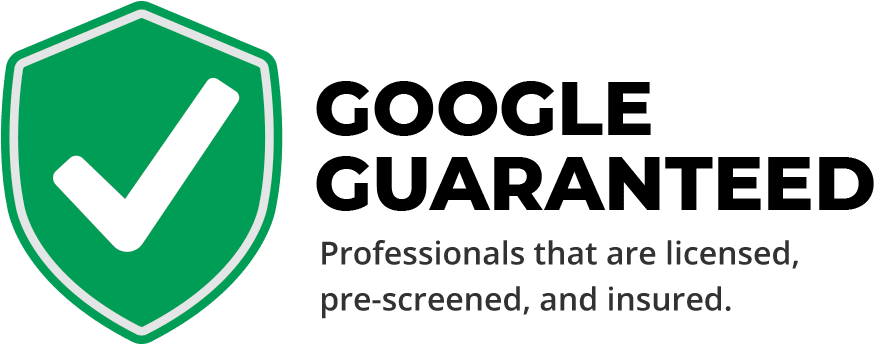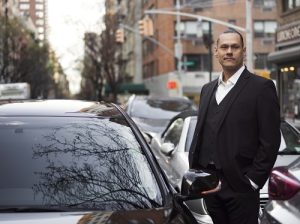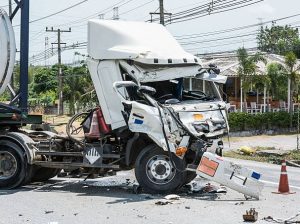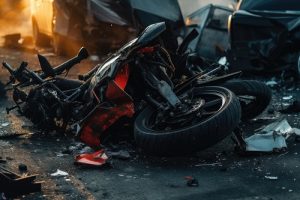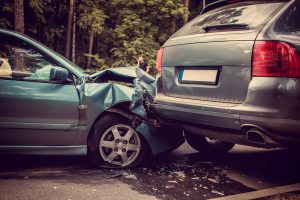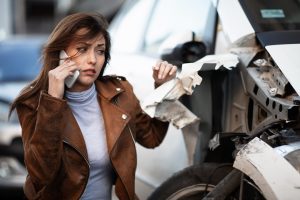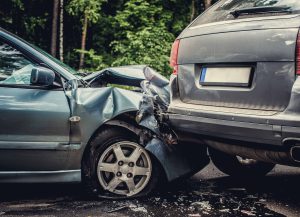Table of Contents
ToggleHit and Run Accident Lawyer
Hit-and-run incidents, where a driver leaves the scene of an accident without providing contact information or rendering aid, are a disturbing and growing concern in many communities. These incidents not only exacerbate the physical and emotional toll on the victims but also present significant challenges to law enforcement and the legal system. The anonymity of the offending driver adds a layer of complexity to the investigation, making it difficult for victims to receive compensation for their injuries and damages. Moreover, the act of fleeing the scene reflects a blatant disregard for the law and the well-being of others, contributing to a sense of injustice and insecurity within affected communities. This blog aims to explore the multifaceted impact of hit-and-run incidents, discuss the legal repercussions for perpetrators, and highlight the importance of community and technological solutions in addressing this issue.
Firstly, the immediate aftermath of a hit-and-run can be chaotic and confusing for the victim. Personal Injuries may be severe, requiring urgent medical attention, and the shock of the event can make it difficult to remember important details about the fleeing vehicle. Witnesses, if any, play a crucial role in these situations, providing valuable information that can aid in the identification of the offender. Law enforcement agencies often rely on surveillance footage, vehicle debris, and eyewitness accounts to track down the responsible party. However, the success rate of these investigations varies significantly, with many cases remaining unsolved due to the lack of concrete evidence. This uncertainty adds a layer of distress for victims and their families, who are left to navigate the aftermath without closure.
The legal consequences for individuals found guilty of a hit-and-run can be severe and are designed to deter such irresponsible behavior. Depending on the jurisdiction, penalties can include hefty fines, license suspension, and even imprisonment, especially if the incident resulted in serious injury or death. These legal measures underscore the gravity of fleeing the scene of an accident and the societal expectation for drivers to take responsibility for their actions. However, the effectiveness of these penalties as a deterrent is often questioned, as hit-and-run incidents continue to occur with alarming frequency.
Combatting Hit-and-Run Incidents: Challenges, Impacts, and Solutions
Victims of hit-and-run incidents face a daunting path to recovery, both physically and financially. Medical bills can quickly accumulate, and without the identification of the at-fault driver, victims may struggle to secure compensation through insurance claims. Many are forced to rely on their insurance policies under uninsured motorist coverage, which may not fully cover the extent of their losses. This financial strain is compounded by potential lost wages and the long-term effects of injuries, which can profoundly alter the course of a person’s life.
The emotional and psychological impact of being involved in a hit-and-run cannot be overstated. Victims often experience feelings of anger, frustration, and helplessness, particularly in cases where the perpetrator is not apprehended. The sense of violation and injustice can lead to lasting trauma, affecting individuals’ ability to feel safe on the road. Support from family, friends, and professional counselors is crucial in helping victims navigate these complex emotions and begin the process of healing.
Community awareness and education are vital components in the fight against hit-and-run incidents. Public campaigns that highlight the consequences of leaving the scene of an accident, combined with strategies to improve witnesses’ responsiveness, can make a significant difference. Encouraging drivers to take responsibility for their actions and fostering a culture of accountability can help reduce the prevalence of these crimes. Additionally, community-led initiatives, such as neighborhood watch programs, can enhance surveillance and reporting, aiding law enforcement efforts.
Technological advancements offer promising solutions to the problem of hit-and-run incidents. The increasing use of dashcams in vehicles, for example, provides crucial evidence that can aid in identifying fleeing drivers. Similarly, smart city technologies, including advanced traffic surveillance systems and automated license plate readers, can significantly improve the chances of apprehending offenders. These tools not only assist in investigation efforts but also serve as deterrents, as drivers become aware of the heightened risk of detection.
5 Hit and Run Accident Examples
Hit-and-run accidents can vary widely in their circumstances and severity, ranging from minor fender benders in parking lots to fatal collisions involving pedestrians or cyclists. Here are five examples that illustrate the breadth of these incidents:
1. Pedestrian Struck at a Crosswalk: In a bustling city, a pedestrian was crossing the street at a marked crosswalk with the right of way when a speeding car ran the red light and struck the individual. Instead of stopping to offer assistance or call for emergency services, the driver sped away, leaving the victim with critical injuries. Surveillance cameras in the area captured the incident, leading to a public appeal for witnesses to help identify the fleeing vehicle.
2. Cyclist Side-Swiped by a Passing Vehicle: A cyclist riding in a designated bike lane during the early morning hours was side-swiped by a vehicle whose driver was attempting to overtake another car. The impact caused the cyclist to fall, suffering from multiple fractures and lacerations. The driver did not stop to acknowledge the crash or provide aid, leaving the scene before anyone could note the license plate number.
3. Parking Lot Fender Bender: In a crowded shopping mall parking lot, a driver backing out of a space collided with another parked car, causing noticeable damage to the bumper and taillights. Instead of leaving contact information for the car’s owner or reporting the incident to mall security, the driver quickly left the scene. The damaged car’s owner returned to find their vehicle harmed and no note, with only nearby shoppers mentioning they saw the other car leave.
4. Fatal Hit-and-Run on a Highway: Late at night on a poorly lit section of highway, a driver struck a pedestrian walking along the roadside. The pedestrian was fatally injured and pronounced dead at the scene. The driver, who left no evidence of attempting to stop or call for help, continued driving, leaving law enforcement to rely on debris from the vehicle and any possible witnesses to track down the responsible party.
5. Multi-Vehicle Collision at an Intersection: A driver running a red light caused a multi-vehicle collision at a busy intersection, resulting in injuries to several people and significant damage to the cars involved. Panicking, the driver responsible for the accident drove away from the chaos, not waiting for emergency services to arrive or to exchange insurance information. Witnesses and traffic cameras described the vehicle, which led to the driver’s eventual identification and arrest.
These examples highlight the diverse nature of hit-and-run accidents and the challenges they pose for victims, witnesses, and law enforcement in seeking justice and compensation for the damages and injuries caused.

The role of law enforcement in addressing hit-and-run incidents is critical. Police departments must prioritize these cases, allocating resources to ensure thorough investigations and the pursuit of justice for victims. This includes training officers in the latest investigative techniques and fostering collaborations with other agencies and the community. The effectiveness of law enforcement’s response can greatly influence the public’s confidence in the legal system’s ability to handle such crimes.
Legal reforms are also necessary to provide better support and protection for hit-and-run victims. This could include streamlining the process for claiming compensation, even in the absence of the at-fault driver’s identification, and increasing the penalties for those found guilty of hit-and-run offenses. Lawmakers must continually assess the adequacy of existing laws and consider new legislation that addresses the evolving nature of these incidents.
Insurance companies play a crucial role in the aftermath of a hit-and-run, providing financial relief to victims. However, the relationship between victims and insurers can be fraught with challenges, as claims processes are often complex and drawn out. There is a need for more transparent and victim-friendly practices, ensuring that individuals receive the support and compensation they are entitled to without undue delay.
How Hit and Run Attorneys Work?
Hit and Run incidents represent a complex and multifaceted problem that requires a coordinated response from all segments of society. From the immediate aftermath of an accident to the long-term recovery of victims, the impact of these crimes is profound and far-reaching. Efforts to reduce the occurrence of hit-and-run incidents and support those affected must be comprehensive and continuous, involving legal, technological, and community-based strategies.
Education and awareness campaigns play a critical role in changing driver behavior. By highlighting the moral and legal responsibilities of drivers involved in accidents, we can foster a culture of accountability. These campaigns should target drivers of all ages, emphasizing that fleeing the scene of an accident only compounds the consequences for everyone involved. Additionally, educational programs should also inform pedestrians and cyclists about the importance of vigilance and safe practices on the roads, reducing the likelihood of accidents.
Technological solutions, while promising, must be implemented with considerations for privacy and accessibility. As cities adopt more surveillance and smart technology to combat hit-and-run incidents, it’s crucial to balance safety improvements with respect for individual privacy rights. Moreover, technology should be accessible to communities of all socio-economic backgrounds, ensuring that safety measures do not disproportionately benefit wealthier neighborhoods over others.
The legal system’s role extends beyond penalizing offenders to protecting and compensating victims. Legal reforms should focus on easing the claims process for victims, ensuring that they receive timely and fair compensation. This includes reconsidering the thresholds for uninsured motorist coverage and exploring new insurance models that better cater to the needs of hit-and-run victims.
Building Safer Roads: Engaging Communities for Prevention and Accountability
Community engagement is essential for creating safer roads. Local initiatives, such as community watch programs and partnerships with law enforcement, can deter potential offenders and aid in the resolution of cases. Communities can also advocate for better road designs that prioritize pedestrian and cyclist safety, reducing the chances of accidents.
On a broader scale, policymakers must consider long-term urban planning and transportation policies that reduce dependency on vehicles and encourage safer modes of transport. Investing in public transportation, creating pedestrian-friendly zones, and promoting cycling can decrease the likelihood of accidents and, by extension, hit-and-run incidents.
The fight against hit-and-run incidents is a shared responsibility that demands action from individuals, communities, and governments. By working together to implement effective prevention strategies, support victims, and bring perpetrators to justice, we can make significant strides toward safer roads for everyone. The path forward requires a commitment to education, innovation, and compassion, ensuring that the devastating impact of hit-and-run incidents is addressed with the seriousness it deserves.
You May Be Eligible to Receive Compensation
The Law Offices of Wolf & Pravato help Florida car accident victims collect the fair compensation they deserve. We may be able to help you recover damages that include money for:
- Current and future medical bills
- Lost wages
- Reduced earning capacity
- Pain suffering and inconvenience
- Loss of enjoyment of life
- And more if you qualify
Reach out to our team today for more information.
Call for a Free Florida Hit and Run Accident Case Evaluation
Let the Law Offices of Wolf & Pravato handle your Florida hit-and-run car accident claim. We offer a free case evaluation and never charge a fee until you get paid. To speak with a Florida hit-and-run accident lawyer from our team today, call us at (954) 633-8270.


